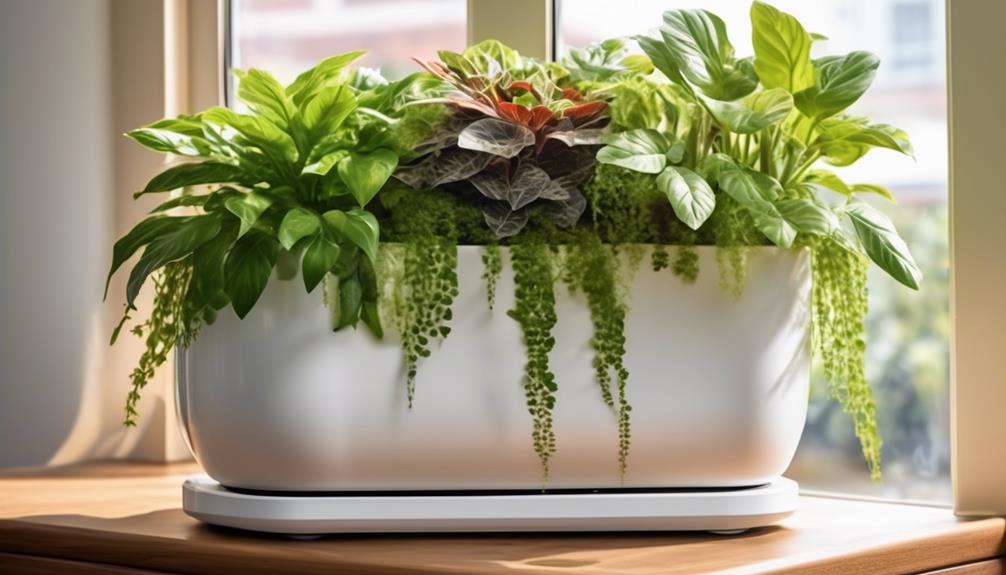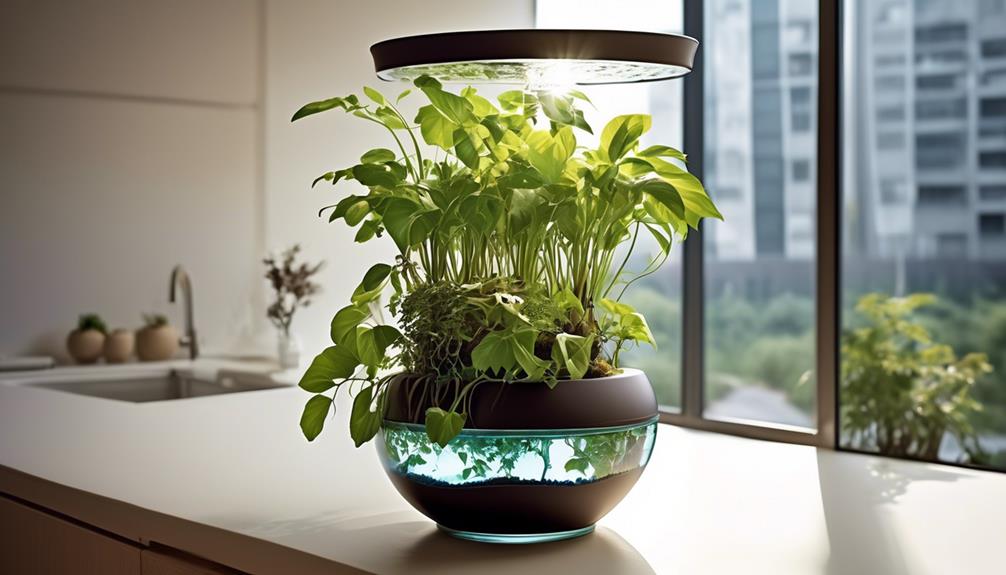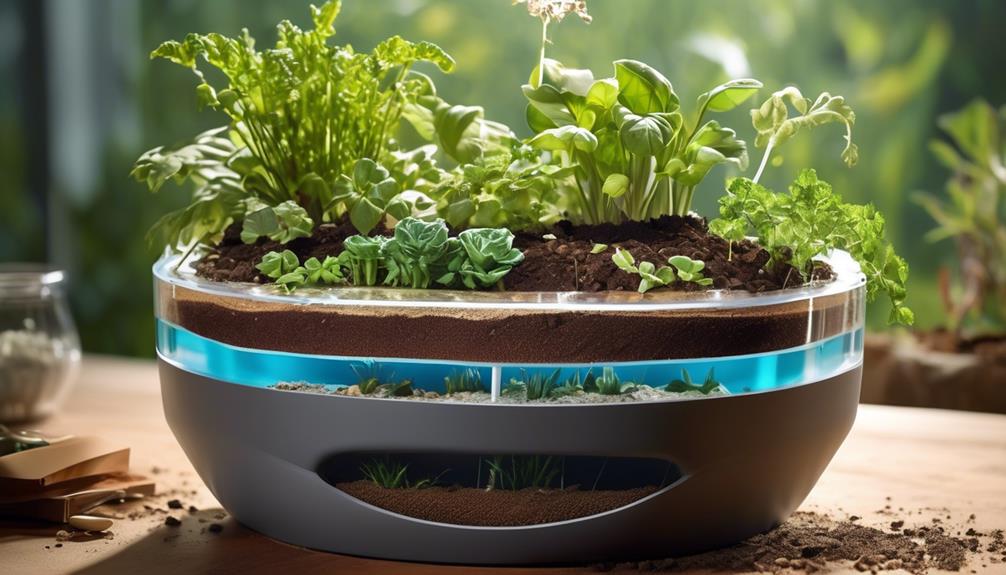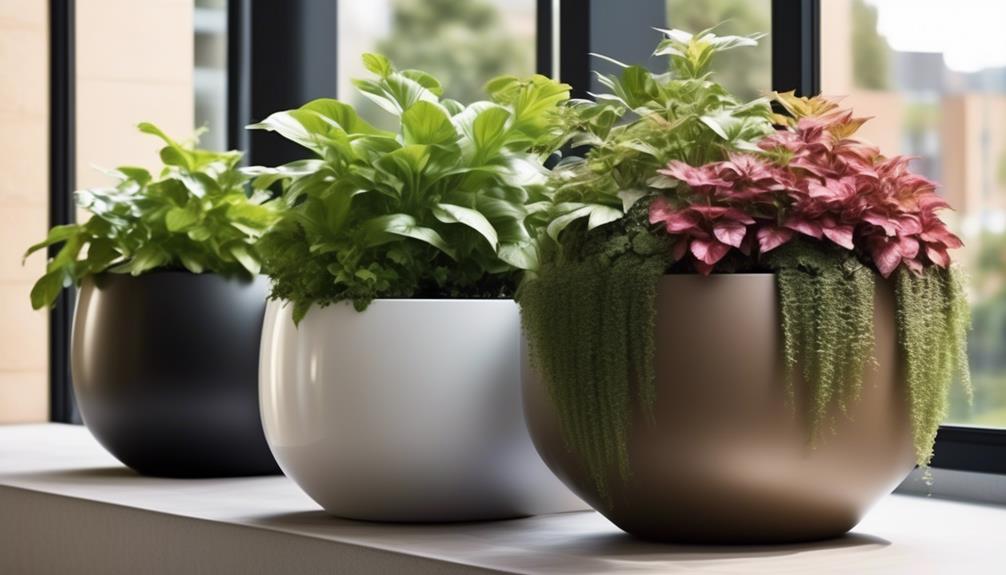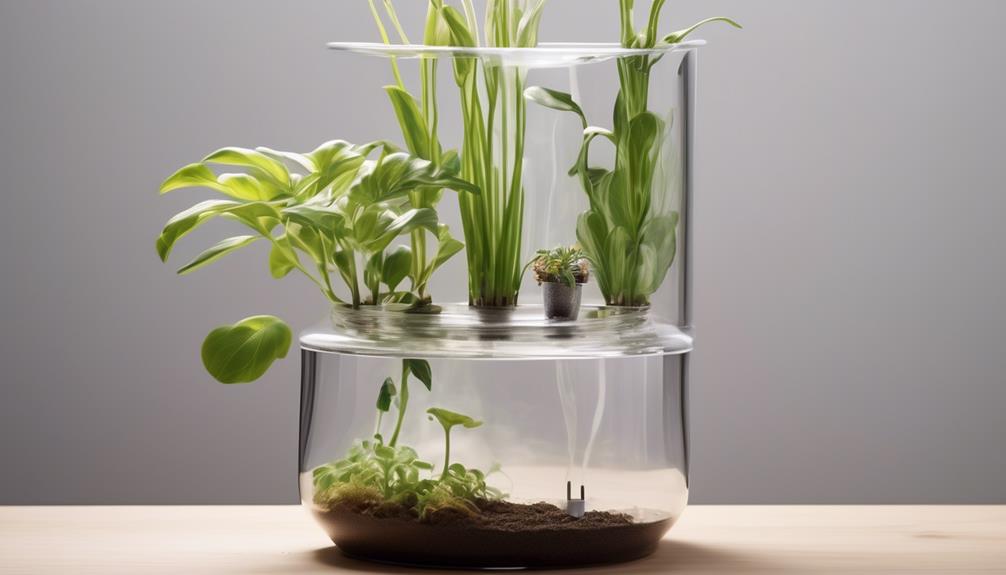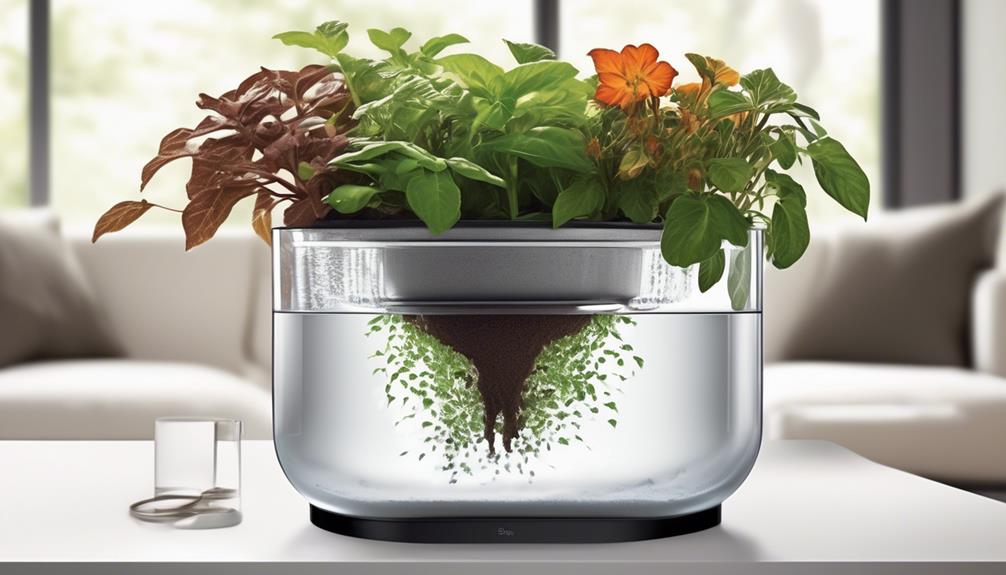Have you tried your best to keep your plants alive, but they still ended up dying? You’re not alone in this struggle.
But what if I told you there's a way to keep your plants perfectly watered without the constant monitoring and guesswork? Self-watering plant pots are revolutionizing the way we care for our green friends, and the benefits are undeniable.
From saving time and water to promoting healthier root systems, these clever systems are changing the game for plant enthusiasts everywhere.
But how do they work, and which plants are best suited for them? Stick around to find out how self-watering plant pots can transform your gardening experience.
Key Takeaways
- Self-watering plant pots utilize a reservoir to supply water to the plant and maintain optimal moisture levels.
- These systems promote root development, overall plant health, and reduce water wastage.
- Choosing the right self-watering pot involves considering the specific needs of each plant, matching pot size to the root structure and water requirements, and selecting a suitable pot material.
- Regular maintenance of self-watering planters includes checking and adjusting water reservoir levels, cleaning the system, and troubleshooting common issues like overwatering or underwatering.
How Self-Watering Plant Pots Work
Self-watering plant pots function by utilizing a reservoir to supply water to the plant as needed, ensuring optimal moisture levels for healthy growth. This innovative system allows for a consistent watering frequency, preventing the plant from experiencing periods of drought or excess moisture. The key to the self-watering mechanism lies in maintaining an ideal soil moisture level, which is crucial for the well-being of the plant. By drawing water from the reservoir through capillary action, the soil remains consistently moist, promoting root development and overall plant health.
Understanding the watering frequency is essential in maximizing the benefits of self-watering plant pots. The reservoir should be regularly checked to ensure an adequate water supply, especially during hot or dry weather conditions when the plant may require more moisture. Additionally, it's important to monitor the soil moisture to prevent overwatering, which can lead to root rot and other detrimental effects on plant health.
Benefits of Self-Watering Systems
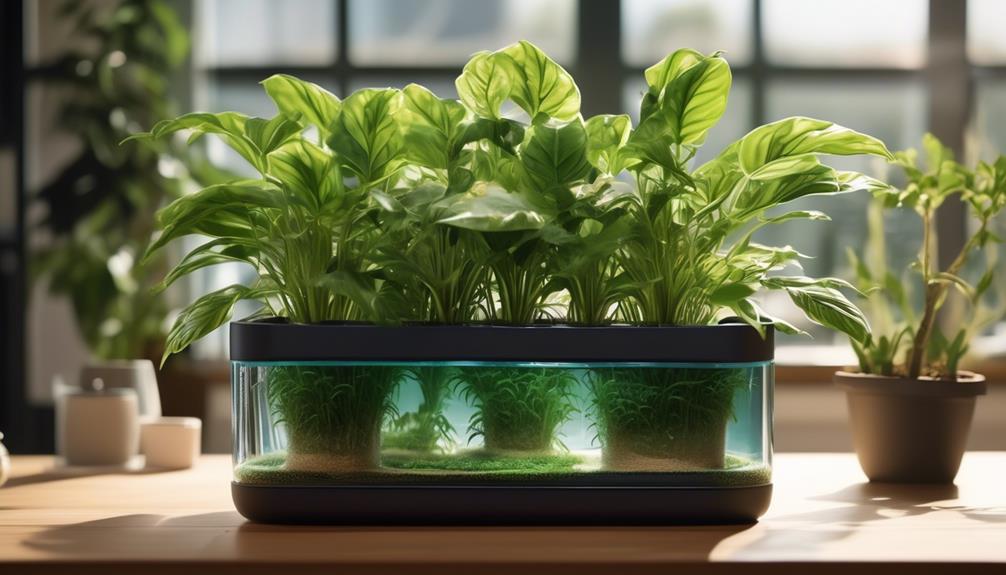
When utilizing self-watering systems for plant care, it's essential to understand the numerous benefits they offer in promoting healthy growth and minimizing maintenance efforts. One of the key advantages is water conservation. Self-watering systems ensure that plants receive the precise amount of water they need, reducing water wastage. This not only helps the environment but also saves you money on water bills.
Additionally, these systems promote healthy roots by providing consistent moisture, which is vital for proper plant growth.
Another significant benefit of self-watering systems is the time-saving aspect. With traditional watering methods, it can be time-consuming to ensure that each plant receives the right amount of water. Self-watering systems eliminate this need, allowing you to spend your time on other essential gardening tasks.
The consistent moisture provided by these systems also reduces the frequency of manual watering, freeing up your time for other activities. Overall, the use of self-watering systems not only promotes plant health but also makes plant care more convenient and efficient.
Choosing the Right Self-Watering Pot
To select the ideal self-watering pot for your plants, consider the specific needs of each type of plant and the pot's reservoir size. Size considerations are crucial when choosing a self-watering pot. Different plant species have varying root structures and water requirements.
For example, plants with deep roots, such as tomatoes or peppers, will benefit from larger reservoirs to ensure an adequate water supply. On the other hand, shallow-rooted herbs like basil or thyme may thrive in smaller reservoirs. It's essential to match the pot size to the specific needs of the plant to avoid overwatering or underwatering.
Material options also play a significant role in choosing the right self-watering pot. Various materials, such as plastic, ceramic, or terracotta, offer different benefits. Plastic pots are lightweight and retain moisture well, making them suitable for many plant types.
Ceramic and terracotta pots are porous, allowing for better airflow to the roots, but may require more frequent watering due to water evaporation. Consider the material's insulating properties and how they may impact the plant's watering needs.
Tips for Maintaining Self-Watering Planters
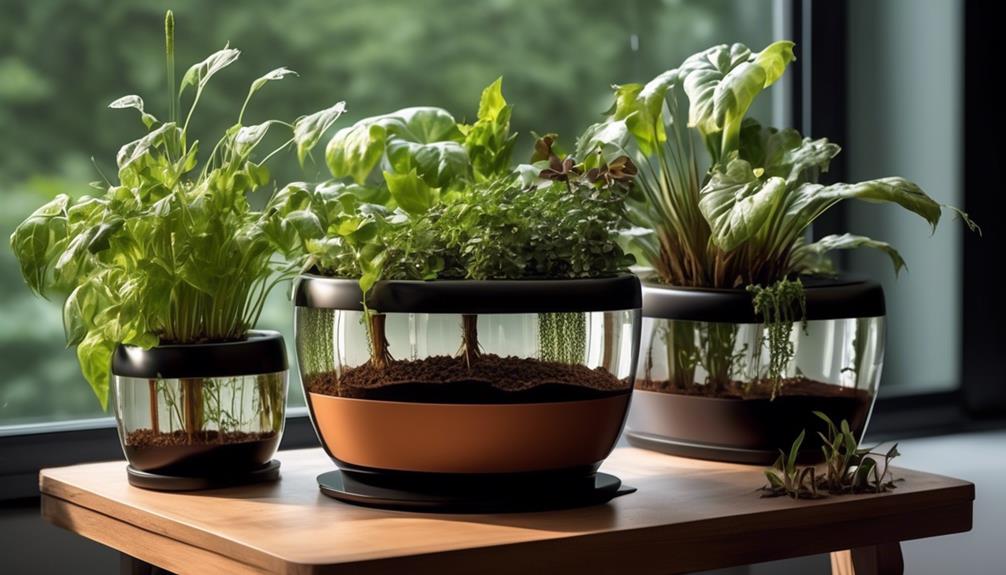
Maintain optimal moisture levels in self-watering planters by regularly checking the water reservoir and adjusting as needed based on the plant's water requirements.
Here are some essential tips for maintaining self-watering planters:
- Monitor Reservoir: Regularly inspect the water reservoir to ensure it's filled to the appropriate level. Adjust the water level based on the plant's needs and environmental conditions.
- Clean the System: Periodically clean the self-watering system to prevent clogs and algae buildup. Use a mild detergent and water to clean the reservoir and the wicking mechanism.
- Troubleshooting Common Issues: Stay vigilant for any signs of overwatering or underwatering. Look for wilting, yellowing leaves, or mold growth, and address these issues promptly.
When maintaining self-watering planters, it's crucial to troubleshoot common issues and address them promptly to ensure the health of your plants.
Additionally, for those interested in exploring DIY self-watering systems, consider researching and implementing different DIY methods to create a self-watering planter tailored to your specific needs.
Regular maintenance and troubleshooting will help to ensure that your self-watering planters provide the necessary moisture for healthy plant growth.
Best Plants for Self-Watering Pots
After ensuring the water reservoir is filled to the appropriate level and cleaning the self-watering system, selecting the best plants for self-watering pots is crucial for successful plant care. When choosing plants for self-watering pots, it's important to consider whether they will be placed indoors or outdoors and whether they are low maintenance or high maintenance. Here are some recommendations to help you make the best choices:
| Indoor Plants | Outdoor Plants |
|---|---|
| Spider Plant | Lavender |
| Peace Lily | Geranium |
| Snake Plant | Petunia |
Indoor plants such as spider plants, peace lilies, and snake plants thrive in self-watering pots as they require minimal maintenance and can adapt well to indoor environments. On the other hand, outdoor plants like lavender, geraniums, and petunias can also flourish in self-watering pots, especially when placed in outdoor settings. These plants are known for their ability to withstand varying weather conditions and can benefit from the consistent moisture provided by self-watering pots. Whether you opt for low maintenance indoor plants or resilient outdoor plants, self-watering pots can help ensure their well-being with minimal effort on your part.
Frequently Asked Questions
Can Self-Watering Plant Pots Be Used for Outdoor Plants as Well as Indoor Plants?
Yes, self-watering plant pots can be used for both outdoor and indoor plants. Outdoor plants may require a different soil variety to accommodate for natural drainage, while indoor plants often thrive in standard potting mix. Understanding these soil variations is essential for proper plant care.
It's crucial to monitor the moisture levels and adjust watering frequency accordingly. Utilizing self-watering pots can provide a consistent water supply, promoting healthier plant growth in both settings.
Are Self-Watering Plant Pots Suitable for All Types of Soil and Plant Varieties?
Absolutely, self-watering plant pots are suitable for a wide variety of soil and plant types. It's essential to consider soil compatibility and the specific watering frequency required for different plant varieties. Understanding these factors will promote healthy plant growth and vitality.
When selecting self-watering pots, it's crucial to match the pot's design to the specific needs of your plants to ensure optimal growth and hydration.
Do Self-Watering Plant Pots Require Any Special Maintenance or Cleaning Procedures?
Cleaning procedures and maintenance requirements are essential for the proper functioning of self-watering plant pots. Regular cleaning and maintenance help prevent clogs, mold growth, and mineral buildup, ensuring optimal water distribution and plant health.
It's important to follow specific cleaning procedures and maintenance schedules to keep the system running smoothly. Proper care and attention will maximize the benefits of self-watering plant pots for a variety of soil types and plant varieties.
Can Self-Watering Plant Pots Be Used for Larger Plants or Trees, or Are They Only Suitable for Smaller Plants?
Yes, self-watering plant pots can be used for larger plants and trees. The key is to ensure that the pot size and water reservoir are adequate for the specific plant's needs.
Larger plants and trees may require a larger pot with a bigger water reservoir to sustain their growth. It's important to choose self-watering pots designed for larger plants or trees to ensure they receive the proper hydration and care.
Are There Any Potential Drawbacks or Limitations to Using Self-Watering Plant Pots?
Potential drawbacks of self-watering plant pots include the maintenance requirements. It's essential to monitor water levels and clean the system regularly. However, the cost-effectiveness and environmental impact of reducing water waste make them worthwhile.
We've found that these drawbacks are manageable with proper care. Our expertise in plant care ensures that we can guide you in maximizing the benefits and minimizing the limitations of self-watering plant pots.
Are Oyama Self-Watering Plant Pots Better Than Other Self-Watering Systems?
When it comes to convenience and functionality, self watering plant pots Oyama stand out among other self-watering systems. The unique design allows for better moisture control and reduces the risk of over or under-watering. With Oyama self-watering plant pots, you can enjoy healthy and thriving plants with minimal effort.
Conclusion
In conclusion, self-watering plant pots offer a convenient and efficient way to keep your plants hydrated.
With their innovative design, these systems provide the perfect amount of water to your plants, ensuring they thrive and flourish.
By choosing the right pot and maintaining it properly, you can enjoy the benefits of self-watering planters for a variety of plant types.
So, sit back, relax, and watch your plants thrive with the help of a self-watering system.

